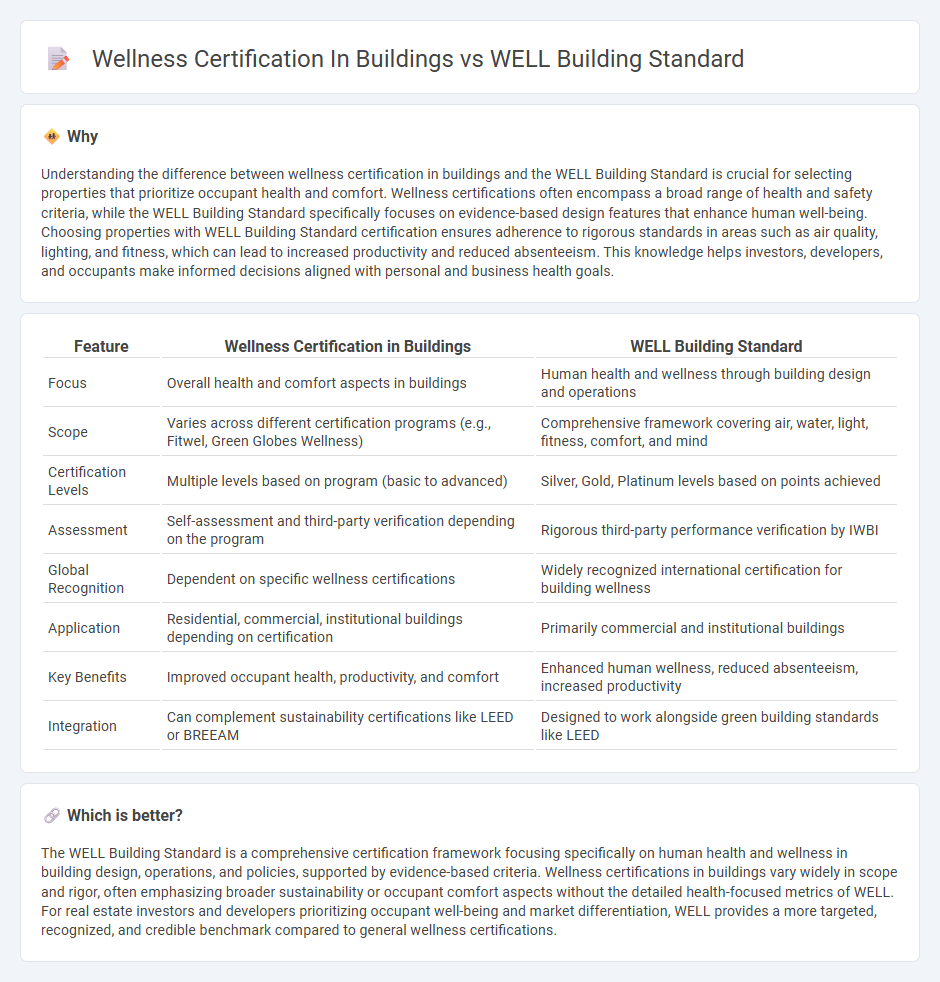
Wellness certification in real estate evaluates buildings based on health-focused criteria such as air quality, lighting, and access to nature, promoting occupant well-being. The WELL Building Standard is a specific, performance-based system that sets rigorous guidelines and measurable metrics to optimize human health and comfort in the built environment. Explore the key differences and benefits of these certifications to enhance your real estate projects.
Why it is important
Understanding the difference between wellness certification in buildings and the WELL Building Standard is crucial for selecting properties that prioritize occupant health and comfort. Wellness certifications often encompass a broad range of health and safety criteria, while the WELL Building Standard specifically focuses on evidence-based design features that enhance human well-being. Choosing properties with WELL Building Standard certification ensures adherence to rigorous standards in areas such as air quality, lighting, and fitness, which can lead to increased productivity and reduced absenteeism. This knowledge helps investors, developers, and occupants make informed decisions aligned with personal and business health goals.
Comparison Table
| Feature | Wellness Certification in Buildings | WELL Building Standard |
|---|---|---|
| Focus | Overall health and comfort aspects in buildings | Human health and wellness through building design and operations |
| Scope | Varies across different certification programs (e.g., Fitwel, Green Globes Wellness) | Comprehensive framework covering air, water, light, fitness, comfort, and mind |
| Certification Levels | Multiple levels based on program (basic to advanced) | Silver, Gold, Platinum levels based on points achieved |
| Assessment | Self-assessment and third-party verification depending on the program | Rigorous third-party performance verification by IWBI |
| Global Recognition | Dependent on specific wellness certifications | Widely recognized international certification for building wellness |
| Application | Residential, commercial, institutional buildings depending on certification | Primarily commercial and institutional buildings |
| Key Benefits | Improved occupant health, productivity, and comfort | Enhanced human wellness, reduced absenteeism, increased productivity |
| Integration | Can complement sustainability certifications like LEED or BREEAM | Designed to work alongside green building standards like LEED |
Which is better?
The WELL Building Standard is a comprehensive certification framework focusing specifically on human health and wellness in building design, operations, and policies, supported by evidence-based criteria. Wellness certifications in buildings vary widely in scope and rigor, often emphasizing broader sustainability or occupant comfort aspects without the detailed health-focused metrics of WELL. For real estate investors and developers prioritizing occupant well-being and market differentiation, WELL provides a more targeted, recognized, and credible benchmark compared to general wellness certifications.
Connection
Wellness certification in buildings focuses on enhancing occupant health, comfort, and productivity by evaluating air quality, lighting, and ergonomics, which aligns closely with the WELL Building Standard. The WELL Building Standard, developed by the International WELL Building Institute (IWBI), provides a comprehensive framework that integrates evidence-based design strategies to promote human well-being in real estate development. This certification system drives real estate projects to prioritize sustainable, health-forward environments that boost asset value and tenant satisfaction.
Key Terms
Indoor Air Quality
WELL Building Standard emphasizes rigorous indoor air quality criteria, including ventilation effectiveness, pollutant reduction, and air filtration to enhance occupant health and comfort. Wellness certifications, while also addressing indoor air quality, often integrate broader health factors like lighting, ergonomics, and mental well-being. Explore detailed comparisons of these standards to understand their impact on indoor environmental quality and human health.
Occupant Health
The WELL Building Standard specifically targets occupant health by integrating evidence-based design and operational strategies that enhance air quality, lighting, and thermal comfort to promote physical and mental well-being. Wellness certification encompasses a broader scope, often including lifestyle and organizational culture factors alongside building features to create a holistic environment. Explore the detailed distinctions between WELL Building Standard and wellness certifications to optimize occupant health in your projects.
Certification Criteria
The WELL Building Standard emphasizes health-driven design elements such as air quality, lighting, and thermal comfort to optimize occupant wellness, with stringent certification criteria including precondition and optimization features validated through performance testing. Wellness certifications often incorporate broader sustainability metrics, integrating physical, mental, and social well-being aspects with flexible criteria tailored by various organizations like Fitwel or Living Building Challenge. Explore detailed differences and certification steps to determine the most suitable wellness framework for your building project.
Source and External Links
WELL Building Standard - The WELL Building Standard is a healthy building certification program developed by the International WELL Building Institute, focusing on evidence-based practices for human health and wellbeing in the built environment.
WELL Building Standard | 5-minute guide - This guide provides an overview of the WELL Building Standard, highlighting its performance-based system designed to measure, certify, and monitor building features impacting human health and wellbeing.
What to Know About the WELL Building Standard - This article explains the history, purpose, and significance of the WELL Building Standard, which is the world's first standard centered solely on human health and safety in buildings.
 dowidth.com
dowidth.com